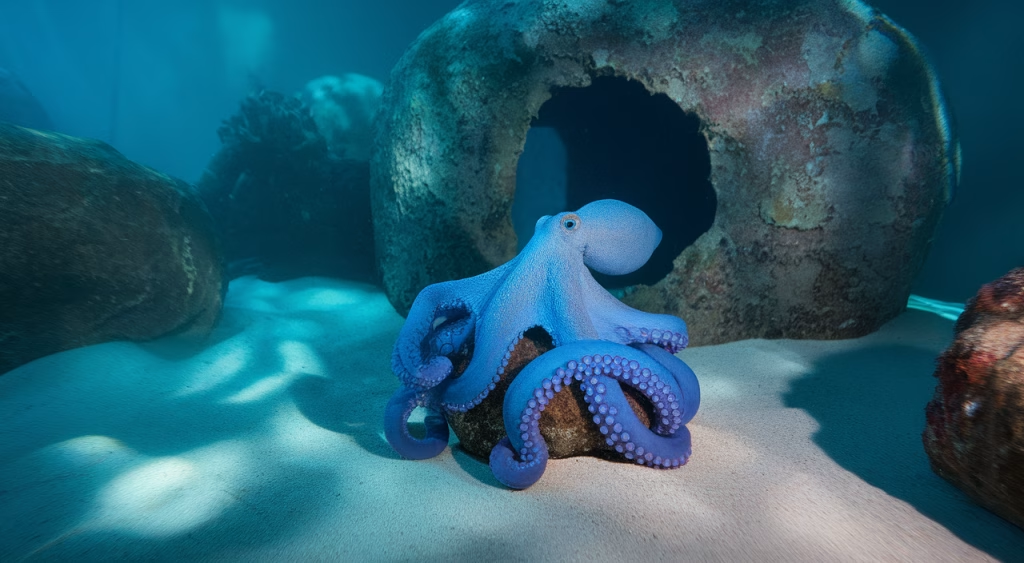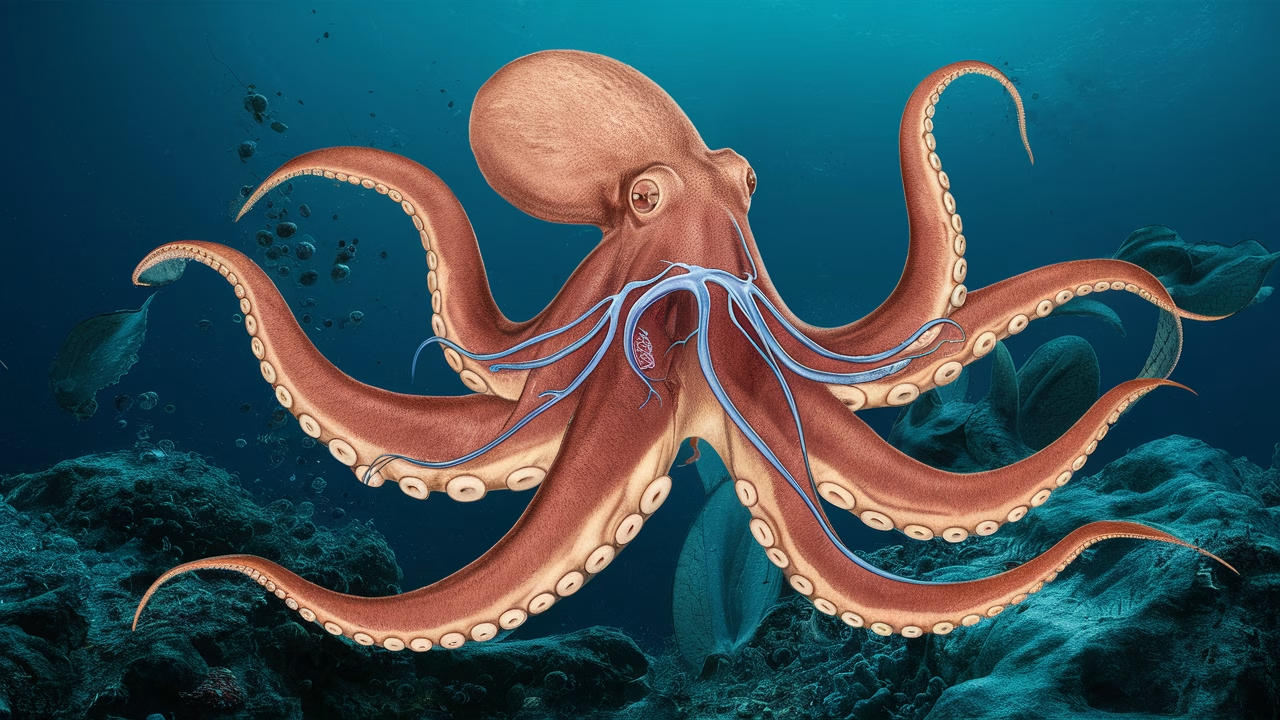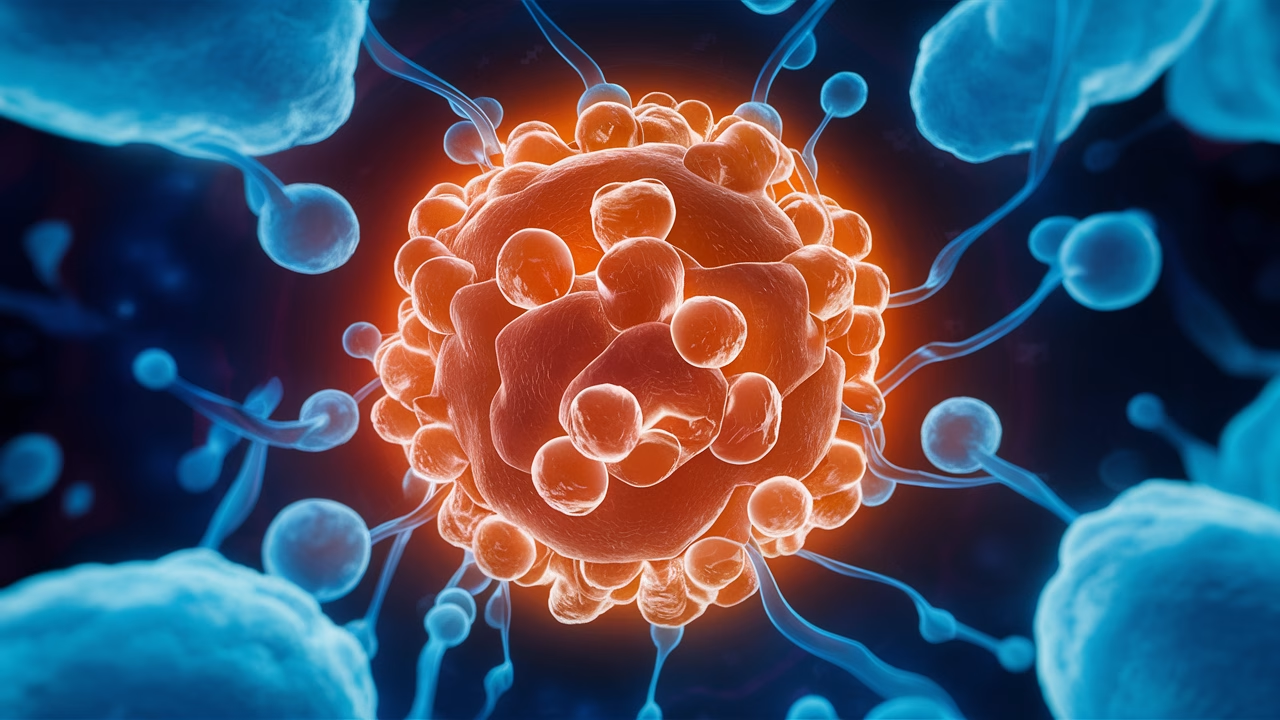Why do octopuses have blue blood?
Because their blood contains a copper-based molecule called hemocyanin instead of the iron-based hemoglobin found in humans. This copper-based molecule hemocyanin in octopus allows them to efficiently transport oxygen in the frigid, low-oxygen environments of the deep sea.
TL;DR: Understanding Why Octopuses Have Blue Blood
- Copper-Based Chemistry: Octopus blood uses hemocyanin — a copper-centered molecule — to transport oxygen, appearing blue when oxygenated.
- Deep Ocean Adaptation: Cold, oxygen-poor waters make hemocyanin more effective than hemoglobin at binding oxygen under extreme conditions.
- Three-Heart System: Octopuses have two branchial hearts for the gills and one systemic heart; their unique blood supports this high oxygen demand.
- Evolutionary Advantage: Over millions of years, this adaptation made octopuses better suited for life in extreme marine habitats.
Understanding Octopus Anatomy and Physiology
To fully grasp why the blue blood octopus exists, we first need to explore the remarkable biological machinery that drives their bodies. Octopuses belong to the class Cephalopoda, an incredibly intelligent and adaptive group of mollusks. When it comes to cardiovascular and respiratory systems, they’re about as unconventional as marine animals get.
The Marvel of Three Hearts
Most animals make do with a singular heart, but the octopus runs an entirely different circuit. It has three hearts, each playing a distinct role in meeting the oxygen requirement in octopus three hearts:
- Two branchial hearts: Located near each gill, these pump oxygen-depleted blood through the gills to absorb oxygen from seawater.
- One systemic heart: This larger heart pumps the newly oxygenated blood throughout the rest of the body.
What’s striking is that the systemic heart actually stops beating when the octopus swims. That’s one reason octopuses prefer crawling over gliding — their hearts take a break during high-energy movement. This unique system explains why understanding the oxygen requirement in octopus three hearts is crucial: they need all the oxygen they can get, and their hemocyanin molecule in octopus blood helps deliver it efficiently.
Unveiling the Secret Behind Blue Blood
If you’ve ever seen video footage of an octopus wrapping around coral or slinking into a crevice, you’d notice an unusual hue to its bleeding wounds — it’s not red, but a stunning shade of blue. This isn’t magic; it’s the science behind octopus blood color.
The Intriguing Role of Hemocyanin
Hemocyanin is the copper-based molecule in octopus blood that takes the place of hemoglobin (the iron-based oxygen carrier in humans and most vertebrates). When oxygen binds to the copper ions in hemocyanin, the molecule takes on a vivid blue color — giving rise to the widespread scientific curiosity about octopus blood color.
Whereas hemoglobin is red due to its iron content, the copper molecule in octopus stands out not only in color but also in function. It performs best in environments that would make hemoglobin struggle — specifically, cold and low-oxygen waters where blue blood octopus species thrive.
Evolutionary Adaptation: Why Octopuses Have Blue Blood
One of the most compelling aspects of understanding why do octopuses have blue blood is that it’s not a random trick of nature but rather a well-engineered response to environmental challenges. The evolution of octopus blood color represents millions of years of adaptation.
The Connection Between Oxygen and Hemocyanin
In deep waters, oxygen isn’t readily available. Temperatures drop, and concentrations of dissolved gases can become razor-thin. Here’s where the copper molecule in octopus blood — hemocyanin — outshines iron-based hemoglobin. It binds oxygen more efficiently at low concentrations, which is critical in the frigid abyss where many blue blood octopus species live.
To put it simply: if these cephalopods had iron-based blood like ours, they’d struggle to survive in the habitats they’ve come to dominate. The development of copper-based molecule hemocyanin in octopus is arguably among the greatest hemocyanin adaptations observed in nature — allowing octopuses to unlock habitats other animals couldn’t call home.
Implications and Significance of Octopus Blue Blood
So, now that we understand how and why this phenomenon evolved, let’s explore what blue blood does for the octopus practically. The answer lies in survival, efficiency, and even behavior patterns of these remarkable cephalopods.
Survival Strategies in Low-Oxygen Environments
Think about the thermal vents, deep shelf escarpments, and oxygen-depleted marine trenches where many octopuses roam. In these places, oxygen is often a luxury. Here’s where the hemocyanin molecule in octopus becomes essential.
- Energy Conservation: Octopuses often reduce movement to preserve oxygen, utilizing their blood’s high oxygen-binding affinity to stretch each molecule further.
- Adaptive Behavior: In areas of temporarily poor oxygen, octopuses can still maintain aerobic metabolism despite the scarcity — a trait directly enabled by blue blood.
- Thermal Buffering: Hemocyanin also adapts better to temperature shifts, keeping oxygen delivery stable across gradients found in tidal or deep ocean zones.
In effect, these properties make the blue blood octopus a master of marginal spaces — adding valuable biodiversity in ocean ecosystems perilously close to their oxygen limits.
Final Thoughts: What Blue Blood Teaches Us About Marine Evolution
The octopus isn’t just a wonder for its eight arms or problem-solving intelligence — it’s also a marvel on the molecular level. The presence of copper-based molecule hemocyanin in octopus, the finely tuned oxygen requirement in octopus three hearts, and the elegant dance between physiology and environment all demonstrate nature’s genius.
By understanding how something as seemingly niche as octopus blood color evolved, we gain insights not just into cephalopods — but into the universal principle that form follows function across all life on Earth. The blue blood octopus serves as a perfect example of how marine animals adapt to thrive in even the most challenging ocean environments.
Frequently Asked Questions
- What gives octopus blood its blue color?
Octopus blood is blue because it contains hemocyanin, a copper-based molecule that turns blue when it binds to oxygen. - How many hearts do octopuses have and why?
Octopuses have three hearts: two branchial hearts to pump blood through their gills and one systemic heart for the rest of the body. - Does blue blood affect how octopuses breathe?
Yes, hemocyanin allows efficient oxygen transport even in low-oxygen environments, crucial for bottom-dwelling or deep-sea octopuses. - Is blue blood unique to octopuses?
No, other mollusks and arthropods also use hemocyanin, but the adaptation is especially advanced in octopuses due to their habitat demands. - How does temperature affect octopus blood?
Hemocyanin functions well across a broad range of temperatures, helping octopuses survive in both polar and tropical seas. - Can octopuses switch to anaerobic respiration?
Yes, temporarily. However, hemocyanin helps them delay the switch by maximizing aerobic efficiency first. - Why is this adaptation important?
It allows octopuses to live in niches others can’t — contributing to their astounding evolutionary diversity and success.





